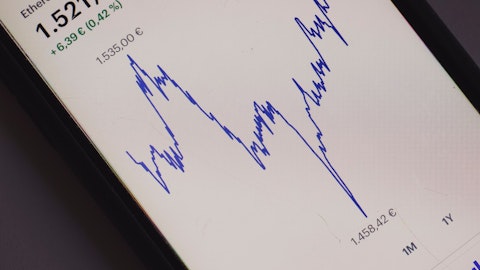As Venkat mentioned, we are the only non-US bank with scale access to the largest capital markets pool in the world. Our businesses are equally weighted among equities, spread and macro. And while individually, these revenue streams can be volatile depending on the operating environment, together, we think they are stable. And lastly, we have grown financing. It is one-third of our revenues today. This is a stable and predictable income that allows us to be more strategic with our clients. So in summary, when you think about markets today, it is a business with deep, broad client relationships. It’s also highly diversified, so it can produce stable double-digit returns. And lastly, it is at scale at scale to be competitive and a relevant player in the market.
Now Venkat talked about simpler, better and more balanced, I will walk you through the same journey and starting with simple. So for us, it’s very simple. Our client franchise is what drives everything. On the top left, you can see through an intense focus on our clients, we have been improving our client franchise. Today, we are a top five client franchise in global markets, in fixed income and in equities. In fact, what is more impressive because you have US banks in the mix here is that we have grown our client franchise by one notch in markets, two notches in fixed income and three notches in equities. Within our client franchise, we have also grown our share with the top 100 clients by 220 basis points. And our growth and progress is not limited to that account base.
We’ve made similar progress with the next 150 and the rest of our clients. Now if you look on the right, you can see how many of our top 100 clients we rank top 5 with. In 2021, that number was 30%. We wanted to deepen our relationships with these clients. Why? Because they are large and they’re growing. They’re also more complex. So they like to partner with the same reliable banks again and again. And that brings more predictability and stability to our income. So we implemented an accountability framework with a lead client executive per account. And we figured out where we needed to lean in across the investment bank and the group versus asking for more. And today, through that framework, we have grown our number to 49. Now we will apply the same framework and intensity of coverage to grow this number further to 70 by 2026.
Now staying on the team of simpler clients are important. They bring us to business, but the stability of our platform relies heavily on how well we risk manage ourselves. On the left, you can see that we have broadly kept flat broadly stable VAR profile despite transacting much more volumes to our platforms. Over the last few years, we’ve also made a deliberate effort to move away from illiquid longer-dated type intermediation activities into more flow focused businesses. And so because of that today, we turn over 80% of our market’s cash balance sheet on a weekly basis. And this is what enables us to outperform in periods of volatility like Q1 2020 and Q2 2022. At the same time, 70% of our capital profile today is under two years, and that is how we recycle 20% of our intermediation RWAs every quarter towards higher returning opportunities.
Now on the right, you can see the bell curve of our income distribution, and you can see how we have shifted it to the right. In 2019, half of our trading days, half of our trading days sat in the £0 to £15 million bucket. Today, we have moved them all into the £16 million to £30 million bucket. This effectively means we have raised the floor on our income, and it also makes us more stable. In this process, we’ve also taken the number of our loss days or loss-making days from 16 to seven in 2023. Now moving to the team of better. Let’s start with our businesses. Here, you can see the strength of our franchise. Our top five revenue rank businesses are 53% of the wallet today. So effectively, we are a top five player in half of the market’s wallet.
This is a very large wallet of nearly £100 billion. And within these businesses, we have a strong market share of 11% today. In 2019, we had 8% market share. And over the last few years, we have grown that, and we’ve held a double-digit market share now for the last three years. Also today, 72% of our income comes from these established capabilities, which again means we are more stable. So how did we achieve this? Since 2019, we used our capital discipline and allocated them an extra five points of capital. And now five years later, their contribution to our revenues has increased by 12 points versus the respective wallet contribution only growing by two points. This tells you that there is strong evidence here that when we provide oxygen to our established capabilities, we can outperform the market.
Let’s take the example of our equity prime business, which Venkat talked about. In 2019, we were outside the top five. This is a business that requires a huge amount of infrastructure. And we know in order to finance a client, we must be able to execute clear, settle and asset service to collateral across all major global markets. So when the operating environment changed in 2020, we invested. And today, we run a top five franchise that actively competes with its US peers. Now I’d like to make two final points on this slide. Firstly, the 11% market share we have here, this is in our established capabilities. We want to grow this further. This is where we have operating leverage. And secondly, as Venkat mentioned, prior to 2019, we did make some very difficult decisions.
We exited commodities. We exited parts of our onshore emerging market trading businesses. We exited parts of our Asia equity business, and that is what has allowed us and enabled us to be consistent to our clients for the last few years. Now moving on to the rest of our franchise. There are parts of our franchise where we are not top five. We still have a healthy market share of 5% within these businesses. And we think about — when we think about these businesses, they are important to us for two reasons. Firstly, they help us maintain a stable ecosystem to our clients, so we can be consistent to our clients. Secondly, they represent opportunities for us either because we have lost some market share or the operating environment is changing.
For example, last year, in European rates and equity directives, we did lose some market share due to idiosyncratic reasons. But traditionally, these businesses have been very large for us because in rates, we have our Sterling franchise. We’re also a primary dealer in 17 countries. And our corporate derivative franchise through banking brings us large structural advantages. Similarly, in equity derivatives, we are one of the largest issuers of structured nodes. So over the last 12 months, we are addressing our platform gaps, and we have already allocated them the capital they need to regain their lost market shares. Securitized products, is a different example. This is where the operating environment has changed. The life cycle here is you originate a pool of assets, you finance those assets and finally, you trade those securities.
We have a top three origination franchise. We’ve built the top five financing franchise, but we did not trade these securities. So in 2021, when QT was starting, we realized there was an opportunity. So we invested in the product. And today, just as the operating environment is improving and our clients need us, our investment is starting to come alive. Now these three opportunities together represent an extra £500 million of revenues for us, and just a 1% market share here gives us an extra £200 million of revenues. So given our historic market shares and the fact that our client franchise has stayed strong within these businesses, it gives us confidence that our plans are measured and prudent. Now staying on the team of better, a common dependency across all of this is technology.
Today, within our trading businesses, our clients increasingly experience us through our electronic offering and in our financing businesses through the stability and delivery of our platforms. Now this experience relies heavily on running a smooth life cycle of a transaction. And the life cycle of a transaction through pre-trade, pricing and post-trade has large dependencies on your technology infrastructure. So our journey here started by simplifying our infrastructure. We started getting rid of legacy applications, legacy point-to-point feed, and we have now decommissioned 84 applications since 2021. Once we simplified our infrastructure, we started modernizing it. We started putting new applications in the cloud. We started containerizing new applications, and we also started creating more reusable applications.
So what happens once you have simplified and modernized your infrastructure, you start to become more stable and agile. And today, we run a much more reliable platform. Our outages are down by 78%, and that is something our clients care about deeply. At the same time, our breaks are down by 53%, and that is something our regulators care about deeply. And finally, now we are more agile. We are releasing more algorithms. We’re deploying product features quicker within our platforms. So, why does all of this matter? Because eventually, we want better electronic platforms, because we want these businesses to play a bigger role in our revenues as their capital-light businesses. And you can see that our efforts are paying off. Today, we are ranked number one on London Stock Exchange, and we have grown our low-touch equity and FX revenues by 87% since 2019.
So finally, moving to the team of more balanced. We want to be more predictable and stable. So we did that by growing financing. Since 2019, through a very deliberate strategy, we have grown our financing revenues at a 13% CAGR for — from £1.8 billion to £2.9 billion in 2023. Today, they represent 36% of our markets revenues, a very stable 36%. Now, why did we want to grow these revenues? Firstly, they represent stable and predictable income for us. Secondly, if you look at all the consolidation, AUM consolidation going on among clients, their financing needs are going up. This gives us an opportunity and enables us to be a much deeper partner with our largest accounts. Thirdly, these are RWA efficient businesses that are secured lending businesses.
So, we like the risk profile — the risk-weighted profile of these businesses. And lastly, there are huge barriers to entry here. So, to operate at scale, you require a huge amount of investment. Now, our platform has been tested over the last few years here. Between 2019 and 2023, there were some very large moves in asset prices. And these moves happen in a very, very short period of time. That is the worst kind of operating environment you can have for this business. Despite all of that, we managed our credit and operational risks very well through this period. Now, I want to share two more facts with you before I leave this slide that gives us confidence in our financing platform today. Today, we have a financing relationship with 96 of our top 100 markets clients.
Secondly, over the last — or since 2021, over 50% — more than 50% of £1 billion-plus hedge fund launches. These are large, very experienced hedge fund managers. They chose Barclays to be their prime broker at the beginning of their journey. That gives us a lot of confidence in our platform, but it also tells you that clients are trusting us at the beginning of their journey. Now, to wrap-up, we will stay focused on clients. We want to further deepen our relationships by achieving a top 5 rank with 70 of our top 100 clients. We’re going to remain prudent around risk and capital management. We’re going to deliver an extra £500 million through a three select intermediation businesses, while maintaining momentum in our top five franchises. We will complete and monetize our technology transformation, so capital-light businesses can play a bigger role.
And finally, we’re going to bring more balance to our financing revenues by growing them by an extra £600 million. Now, I’d like to finish by saying we have been executing a strategy that is working since 2019. We have been consistent to our clients. We have been a reliable partner to our clients. At the same time, we have the ability to produce double-digit returns regardless of the operating environment. So, the next few years are about executing the same strategy with the same precision and discipline that we have applied over the last few years. Thank you. And now I’ll pass it back to Venkat.
C.S. Venkatakrishnan: Thank you, Adeel. So, I’ll wrap up on the Investment Bank. So, what you’ve heard from Adeel in the market side, and what you heard from me is that overall, we intend to improve the investment banks RoTE to be in line with the group target of about 12% — above 12% by 2026. We recognize that this is a significant increase on the 7% last year. And I believe from what I’ve told you though, that and what you’ve heard from a deal, that this is a credible and achievable ambition built from the foundations we’ve developed. Our income growth target in this is a high single-digit CAGR, and it’s firmly predicated on initiatives which are within our control. And it monetizes investments which we have made in cost and capital, driving strong operating jaws and resulting in a cost-to-income ratio in the high 50s.
You have heard that we are limiting the proportion of the Investment Bank RWAs to the rest of the group at around 50% by 2026, as we allocate more capital elsewhere to higher return in consumer and corporate businesses. We can achieve this, while absorbing regulatory inflation within the investment bank, due to the capital discipline, which already exists in our markets business and a pathway to improving return on RWA in the Investment Bank. And as I said at the start of this, we are looking for the Investment Bank overall to do more with less, keeping the cloud clients at the heart of what we do and indeed deepening those relationships with clients. We expect this plan to generate stable and attractive returns on a consistent basis, supporting our group targets and delivering value to our shareholders.
So I will now hand over to Denny Nealon to take you through the US Consumer Bank Presentation.
Denny Nealon: Okay. So, good morning, everybody. I’m Denny Nealon, CEO of the US Consumer Bank, a role I’ve held for the last four years. I’ve been in the financial services industry more than 25 years, having previously worked at JPMorgan Chase and Bank One and have been with Barclays since 2004. I’m excited to be here today and talk with you about the US Consumer Bank, a business that was previously reported within the consumer, cards and payments division. I’ll focus my comments on three areas. First, I’ll provide an overview of the business, as well as some key US market characteristics. Then I’ll review our financial performance and key performance drivers. And finally, I’ll walk through our plan to achieve mid-teens road on a sustainable basis post migration to IRB capital rules.





